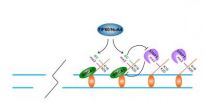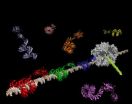(Press-News.org) San Francisco, CA, February 4, 2012 – The Vision Screening Committee of the American Association for Pediatric Ophthalmology and Strabismus, the professional organization for pediatric eye care, has revised its guidelines for automated preschool vision screening based on new evidence. The new guidelines are published in the February issue of the Journal of AAPOS.
Approximately 2% of children develop amblyopia, sometimes known as "lazy eye" – a loss of vision in one or both eyes caused by conditions that impair the normal visual input during the period of development of vision. Amblyopia remains treatable until 60 months, with treatment becoming less effective after age 5.
The AAPOS Vision Screening Committee established the first guidelines for automated preschool vision screening in 2003. These primarily addressed the magnitude of refractive error that was (by consensus) thought to put a child at risk for the development of amblyopia. Since then, more data have emerged about the prevalence of amblyopia risk factors in young children from which it is clear that most children with these risk factors do not develop the condition. Likewise, technology has advanced, and screening instruments are now available that detect abnormalities other than amblyopia risk factors. The Committee has therefore reviewed the new evidence and adjusted its criteria.
"Over the last decade, automated methods for vision screening have progressed to the point where they are now extremely effective in identifying vision problems in children prior to their being able to read an eye chart," said lead author Sean P. Donahue, MD, PhD, of the Department of Ophthalmology and Visual Sciences, Vanderbilt University Medical Center, Nashville, TN. "It is exciting to see pediatricians adopt these technologies."
He continued: "If the detection of decreased vision and amblyopia are the goals of screening, then referrals based on technology that detects risk factors will result in over-referrals. It is therefore imperative that updated guidelines for detecting amblyopia risk factors propose levels that best separate those children who are most at risk for developing amblyopia from those who are not."
The Committee's recommendations include:
Separate criteria for toddlers (12-30 months), early preschool children (31-48 months), late preschool and kindergarten children (49-72 months), and school-aged children (over 72 months)
Lower referral rate for young children by raising the threshold referral values
Use of traditional optotype recognition screening option for school-age children who can read linear letters
Detection of visually significant media opacities and manifest (not intermittent) strabismus at all ages
Instruments that detect amblyopia should report results using amblyopia presence as the gold standard
The Committee also noted that the U.S. Preventive Services Task Force (USPSTF) has specifically endorsed the use of photoscreening modalities for the detection of amblyopia risk factors in the 3- to 5-year-old age group.
Journal of AAPOS Editor-in-Chief Edward G. Buckley, MD, Professor of Ophthalmology and Pediatrics and Vice-Dean of Medical Education at Duke University School of Medicine, commented, "Early detection is critical if we are to be successful in eliminating unnecessary treatable vision loss in children. These new guidelines hopefully will allow children's health care providers to get one step closer to our goal."
### END
New criteria for automated preschool vision screening
Evidence-based guidelines published in the Journal of AAPOS
2013-02-04
ELSE PRESS RELEASES FROM THIS DATE:
A little tag with a large effect
2013-02-04
February 4, 2013, New York, NY and Oxford, UK – Nearly every cell in the human body carries a copy of the full human genome. So how is it that the cells that detect light in the human eye are so different from those of, say, the beating heart or the spleen?
The answer, of course, is that each type of cell selectively expresses only a unique suite of genes, actively silencing those that are irrelevant to its function. Scientists have long known that one way in which such gene-silencing occurs is by the chemical modification of cytosine—one of the four bases of DNA that ...
Shop King Jewelers 2013 Valentine's Day Jewelry Sale for Savings on Unique Valentine's Gifts & Valentine's Day Presents for Men and Women
2013-02-04
Searching for the perfect Valentine's Day gift doesn't have to be a stressful experience. King Jewelers believes that the pursuit of a unique valentine's gift for the one you love can be an enjoyable and extremely personal experience, even online. That's why for this Valentine's Day King Jewelers has put together an exclusive selection of fine jewelry, watches, diamond studs, diamond pendants and accessories for men and women that will make ideal Valentine's Day gift ideas for your loved one.
Valentines Day Gift Ideas for Him and Her
Online shoppers will find a wide ...
DNA reveals mating patterns of critically endangered sea turtle
2013-02-04
New University of East Anglia research into the mating habits of a critically endangered sea turtle will help conservationists understand more about its mating patterns.
Research published today in Molecular Ecology shows that female hawksbill turtles mate at the beginning of the season and store sperm for up to 75 days to use when laying multiple nests on the beach.
It also reveals that these turtles are mainly monogamous and don't tend to re-mate during the season.
Because the turtles live underwater, and often far out to sea, little has been understood about their ...
Changes to DNA on-off switches affect cells' ability to repair breaks, respond to chemotherapy
2013-02-04
PHILADELPHIA - Double-strand breaks in DNA happen every time a cell divides and replicates. Depending on the type of cell, that can be pretty often. Many proteins are involved in everyday DNA repair, but if they are mutated, the repair system breaks down and cancer can occur. Cells have two complicated ways to repair these breaks, which can affect the stability of the entire genome.
Roger A. Greenberg, M.D., Ph.D., associate investigator, Abramson Family Cancer Research Institute and associate professor of Cancer Biology at the Perelman School of Medicine, University of ...
Researchers discover mutations linked to relapse of childhood leukemia
2013-02-04
After an intensive three-year hunt through the genome, medical researchers have pinpointed mutations that leads to drug resistance and relapse in the most common type of childhood cancer—the first time anyone has linked the disease's reemergence to specific genetic anomalies.
The discovery, co-lead by William L. Carroll, MD, director of NYU Langone Medical Center's Cancer Institute, is reported in a study published online February 3, 2013, in Nature Genetics.
"There has been no progress in curing children who relapse, in spite of giving them very high doses of chemotherapy ...
Pioneering research helps to unravel the brain's vision secrets
2013-02-04
A new study led by scientists at the Universities of York and Bradford has identified the two areas of the brain responsible for our perception of orientation and shape.
Using sophisticated imaging equipment at York Neuroimaging Centre (YNiC), the research found that the two neighbouring areas of the cortex -- each about the size of a 5p coin and known as human visual field maps -- process the different types of visual information independently.
The scientists, from the Department of Psychology at York and the Bradford School of Optometry & Vision Science established ...
Immune cell 'survival' gene key to better myeloma treatments
2013-02-04
Scientists have identified the gene essential for survival of antibody-producing cells, a finding that could lead to better treatments for diseases where these cells are out of control, such as myeloma and chronic immune disorders.
The discovery that a gene called Mcl-1 is critical for keeping this vital immune cell population alive was made by researchers at Melbourne's Walter and Eliza Hall Institute. Associate Professor David Tarlinton, Dr Victor Peperzak and Dr Ingela Vikstrom from the institute's Immunology division led the research, which was published today in ...
Growth factor aids stem cell regeneration after radiation damage
2013-02-04
DURHAM, N.C. – Epidermal growth factor has been found to speed the recovery of blood-making stem cells after exposure to radiation, according to Duke Medicine researchers. The finding could open new options for treating cancer patients and victims of dirty bombs or nuclear disasters.
Reported in the Feb. 3, 2013, issue of the journal Nature Medicine, the researchers explored what had first appeared to be an anomaly among certain genetically modified mice with an abundance of epidermal growth factor in their bone marrow. The mice were protected from radiation damage, and ...
Recreating natural complex gene regulation
2013-02-04
DURHAM, N.C. – By reproducing in the laboratory the complex interactions that cause human genes to turn on inside cells, Duke University bioengineers have created a system they believe can benefit gene therapy research and the burgeoning field of synthetic biology.
This new approach should help basic scientists as they tease out the effects of "turning on" or "turning off" many different genes, as well as clinicians seeking to develop new gene-based therapies for human disease.
"We know that human genes are not just turned on or off, but can be activated to any level ...
Plant scientists at CSHL demonstrate new means of boosting maize yields
2013-02-04
Cold Spring Harbor, NY – A team of plant geneticists at Cold Spring Harbor Laboratory (CSHL) has successfully demonstrated what it describes as a "simple hypothesis" for making significant increases in yields for the maize plant.
Called corn by most people in North America, modern variants of the Zea mays plant are among the indispensable food crops that feed billions of the planet's people. As global population soars beyond 6 billion and heads for an estimated 8 to 9 billion by mid-century, efforts to boost yields of essential food crops takes on ever greater potential ...
LAST 30 PRESS RELEASES:
Jeonbuk National University study shows positive parenting can protect adolescents against self-harm
Surface-engineered ZnO nanocrystals to tackle perfluoroalkyl substance contamination
This new understanding of T cell receptors may improve cancer immunotherapies
A new fossil face sheds light on early migrations of ancient human ancestor
A new immunotherapy approach could work for many types of cancer
A new way to diagnose deadly lung infections and save lives
40 percent of MRI signals do not correspond to actual brain activity
How brain-inspired algorithms could drive down AI energy costs
Gum disease may be linked to plaque buildup in arteries, higher risk of major CVD events
Contrails are a major driver of aviation’s climate impact
Structure of dopamine-releasing neurons relates to the type of circuits they form for smell-processing
Reducing social isolation protects the brain in later life
Keeping the heart healthy increases longevity even after cancer
Young adults commonly mix cannabis with nicotine and tobacco
Comprehensive review illuminates tau protein's dual nature in brain health, disease, and emerging psychiatric connections
Book prepares K-12 leaders for the next public health crisis
Storms in the Southern Ocean mitigates global warming
Seals on the move: Research reveals key data for offshore development and international ecology
Sports injuries sustained during your period might be more severe
World's first successful 2 Tbit/s free-space optical communication using small optical terminals mountable on satellites and HAPS
Can intimate relationships affect your heart? New study says ‘yes’
Scalable and healable gradient textiles for multi‑scenario radiative cooling via bicomponent blow spinning
Research shows informed traders never let a good climate crisis go to waste
Intelligent XGBoost framework enhances asphalt pavement skid resistance assessment
Dual-function biomaterials for postoperative osteosarcoma: Tumor suppression and bone regeneration
New framework reveals where transport emissions concentrate in Singapore
NTP-enhanced lattice oxygen activation in Ce-Co catalysts for low-temperature soot combustion
Synergistic interface engineering in Cu-Zn-Ce catalysts for efficient CO2 hydrogenation to methanol
COVID-19 leaves a lasting mark on the human brain
Scientists use ultrasound to soften and treat cancer tumors without damaging healthy tissue
[Press-News.org] New criteria for automated preschool vision screeningEvidence-based guidelines published in the Journal of AAPOS


